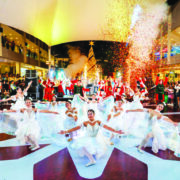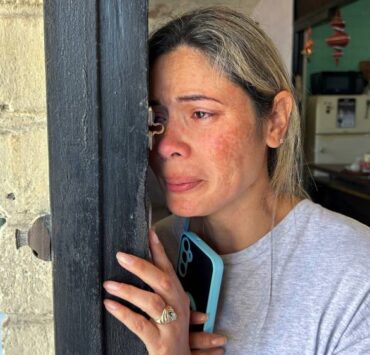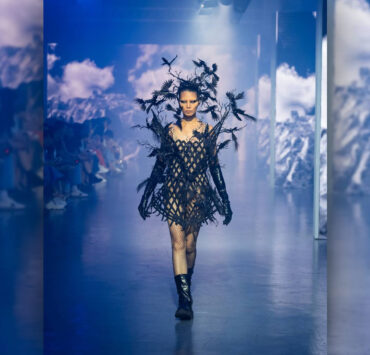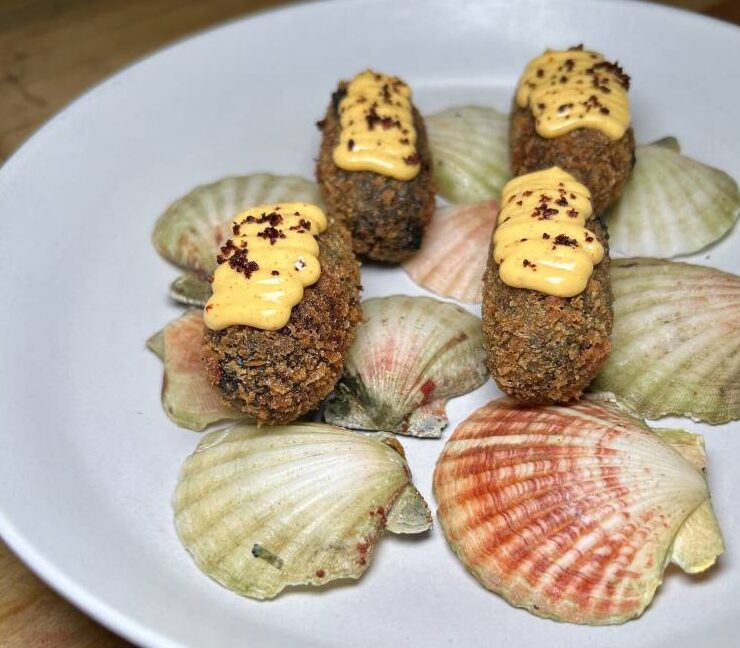Unconventional approaches, unexpected silhouettes
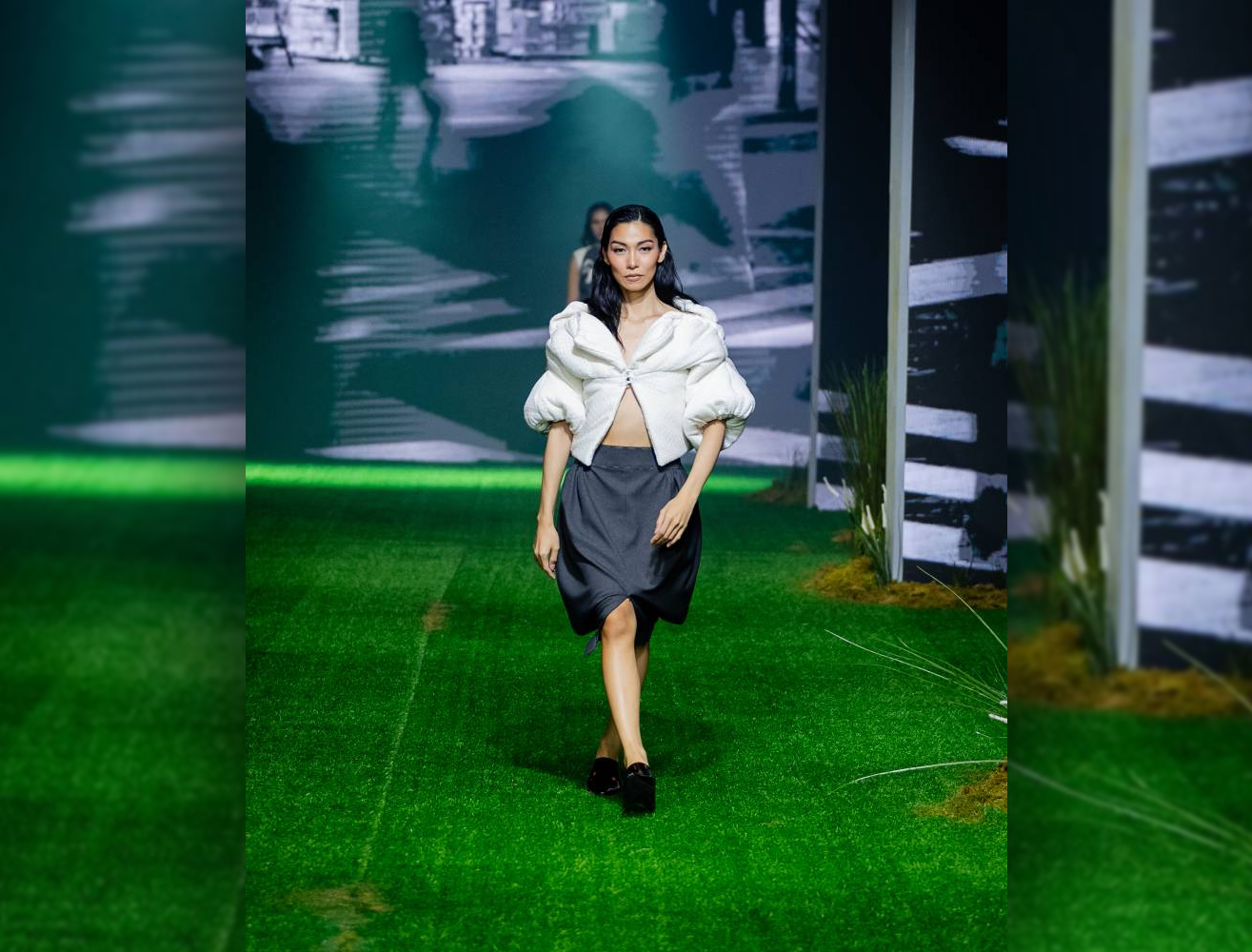
This year’s Bench Design Awards spotlighted designers who fearlessly experimented with their craft. Their winning collections showcased a keen understanding of technique, evident in their unconventional approaches to garment construction. These designers explored unexpected silhouettes, employing innovative fabric treatments and asymmetrical patterns that broke away from traditional forms. Rooted in concepts that blurred the boundaries between art and fashion, their creations, while possessing a distinct flair, remained surprisingly wearable.
Stephany Verano
In Paris, Stephany Verano earned her fashion design diploma (majoring in womenswear, ready-to-wear, and knitwear) from Ecole Superieure des Arts et Techniques de la Mode, widely known as ESMOD. She cultivated her well-rounded experience through internships as an assistant patternmaker at the Swiss brand Vetements, assistant graphic designer/press assistant at the luxury brand La Prestic Quiston, textile assistant at the womenswear label Coralie Marabelle, and atelier assistant at Leonard Paris, a luxury brand celebrated for its prints. Additionally, she assisted textile designer Kirsten Thoerle, whose atelier is renowned for embroidery.
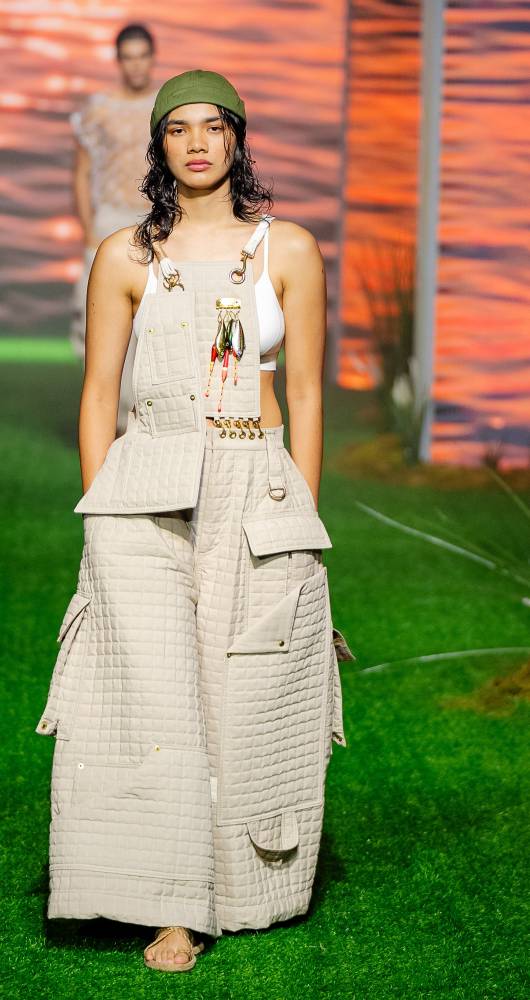
Verano drew inspiration from vintage photographs of European fisherfolk—men in high-waisted trousers, layered garments, and brown fishing gear, and women in draped aprons. She infused feminine details into menswear, such as boat necklines, circular hemlines on shirts, and sheer tops reminiscent of fishing nets. One men’s top was knitted from fishing lines with tassels that evoked fishing baits. Proportions were exaggerated through techniques like quilting, stuffing, knitting, draping, and boning on pants.
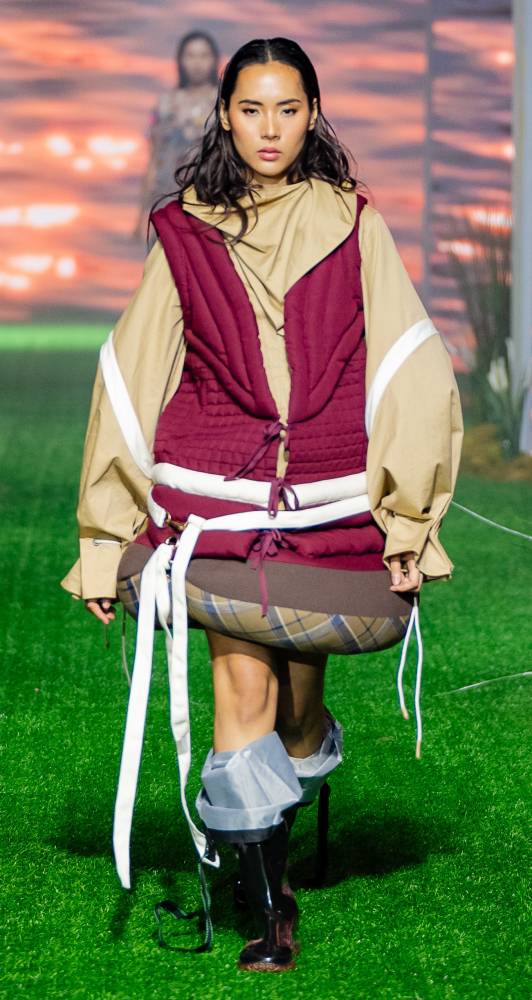
The utilitarian aesthetic featured practical materials such as cotton, polyester wool blends, poly-cotton, wool, and linen. The clothing was rich in details: kangaroo pockets, exaggerated flap pockets, and a back yoke that cleverly doubled as a hidden bag. One female model showcased bib overalls where the top was attached to the waist with eyelet holes and metal hooks. Brass eyelets, rivets, and ropes comprised the hardware. To give the garment flexibility, detachable elements were incorporated, including sleeve appendages to shorten those on a long-sleeved shirt, and utility bags.
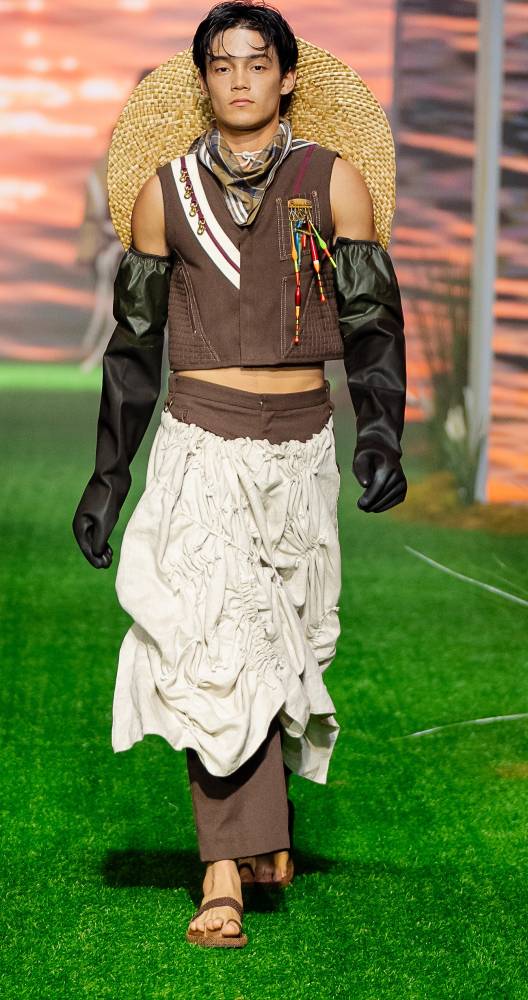
A man’s outfit took inspiration from a fishing vest, presenting quilted panels and various pockets, including a large back pocket. Some of the cut front seams also served as pockets. One side of the vest featured contrasting white twill with brass hooks, while the other side held more hooks, intended for fish baits. The pants included semi-large back pockets and exposed zip pockets at the front, along with D-rings for attaching hooks. Notably, the back of the pants had vents that could be opened or closed to modify the volume. A draped apron skirt with an adjustable rope completed the ensemble.
The female model wore a mustard cotton blouse with a draped collar, paired with a padded and quilted magenta waistcoat that referenced a life vest. This was styled with a short, tire-shaped padded skirt with plaid underneath, evoking a floater.
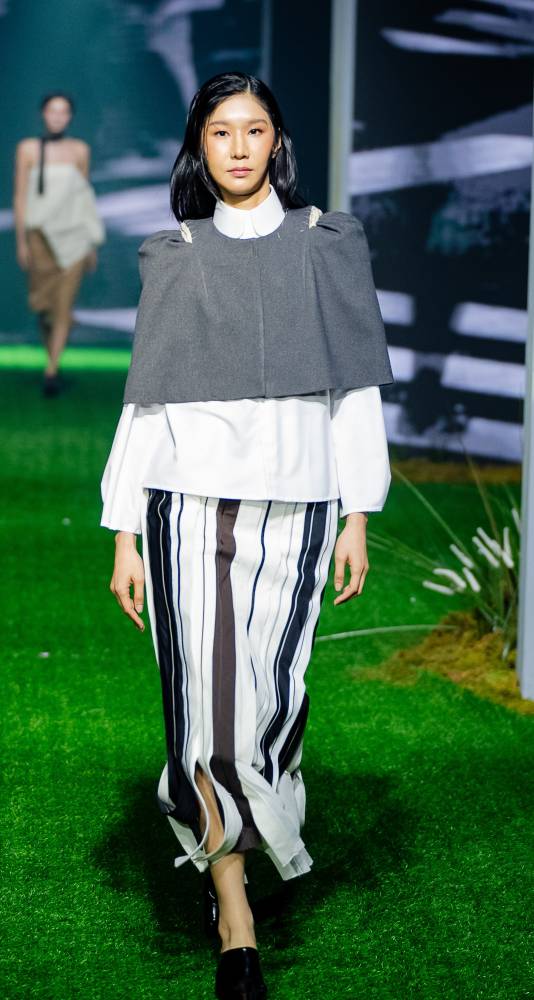
Karl Nadales
Hailed as the heir apparent of mentor Jojie Lloren, Karl Nadales, a top student from FAB (Fashion+Art+Business) Creatives, presented a collection that narrated his transition from the ease of laidback Iloilo to the uncertainty and fast-paced life of Manila. He found his sanctuary at A17, the address of FAB Creatives in Pasay City, and used the often-unseen inner construction techniques and client fittings at the atelier as metaphors for his experience as a migrant.
Nadales likened altering patterns to fit a client’s measurements to his own adjustments to a new environment. Basting stitches along the silhouette, like routes on a map, symbolized his journey. Other impressions included rows of straight waistband strips for men’s pants that formed both a man’s cape and a woman’s top and skirt. The cutting of muslin fabric, draped on a mannequin, was interpreted as a loose cream top with the pattern’s outline twisted to the side. This was worn over loose gray pants, representing the mannequin’s color. His fabric choices ranged from dead stock to wool.
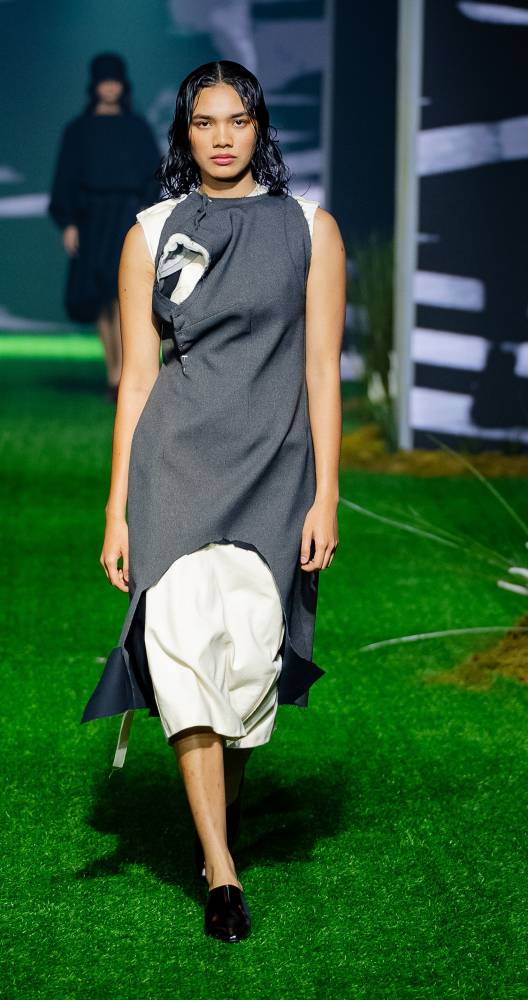
Nadales’ designs intentionally shifted focus away from the typical human form by concealing or altering familiar figurative elements. Imagine an exaggerated armhole unexpectedly placed near the hemline, while the actual armhole remained unused but skewed on the top part of the dress as a detail, or the conventional orientation of skirts and tops completely reversed.
At times, the very construction of a garment was emphasized, perhaps asymmetrically, to accommodate the unique contours of a wearer, such as the curvature caused by scoliosis. Through these techniques, including changes in shape achieved by altering the placement of seams, knotting, and twisting, the distinct outline of the human figure seemed to soften and recede, becoming more of a volume or a flat plane contained within the clothing’s structure.
Lloren expressed his admiration for Nadales’ unconventional thinking, saying, “Karl knows my aesthetics but he has his own. He can design something classic with a twist, but he can also deliver something beyond outrageous.”
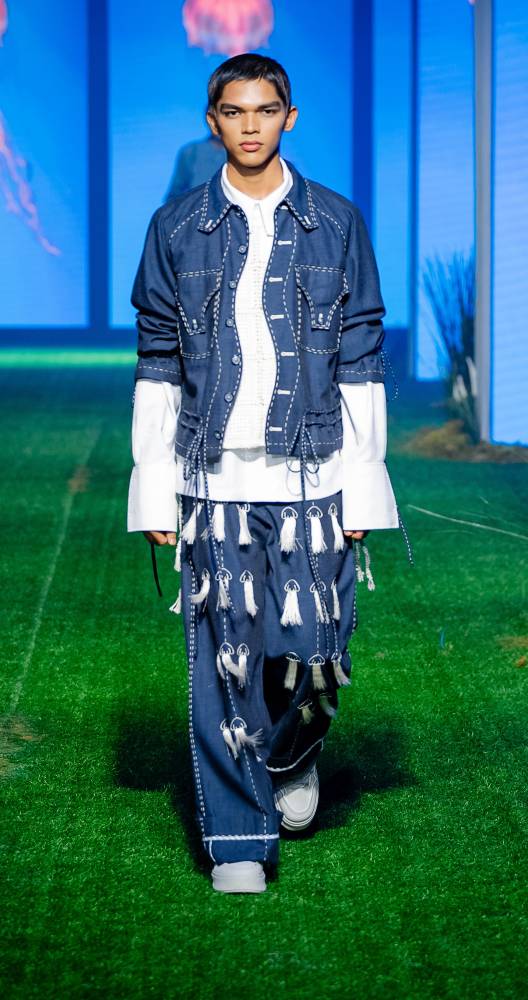
Peter Gagula/Peach Garde
Capiz-born Peter Gagula teaches Men’s Wear at Iloilo Science and Technology University and completed a British Bespoke Tailoring course at Slim’s Fashion and Arts School. The essence of his collection lay not so much in the quirkiness of its nautical theme, but in the principle of wabi-sabi, or a respect for humble materials. Think polyester blends, khaki used for uniforms, and cotton barong. The designs fall under his brand, Peach Garde, which distinguishes itself through its genderless style.
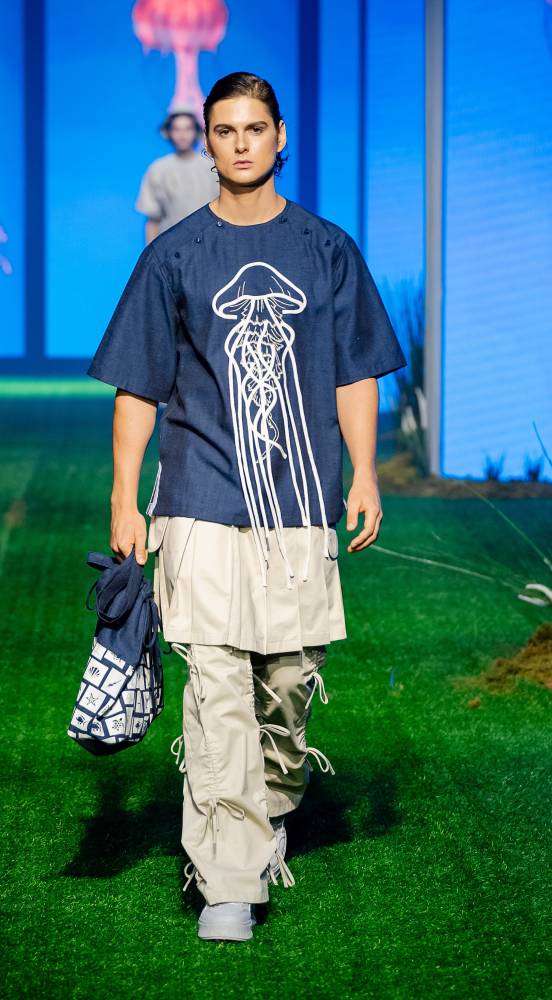
A light blue-and-white striped cotton fabric served as the inspiration for a beach theme. It spawned jellyfish images and undulating flaps that echoed the waves of the sea. The androgynous clothes, primarily modeled by men to showcase Gagula’s tailoring expertise, included a standout denim jacket gathered on the sides and embellished with contrasting basting stitches. The menswear/womenswear was characterized by ruched sleeves, jellyfish motifs rendered as macramé bonnets or embroidered with tassels to emphasize their tentacles, and repetitive wavy flaps on tops and bottoms.
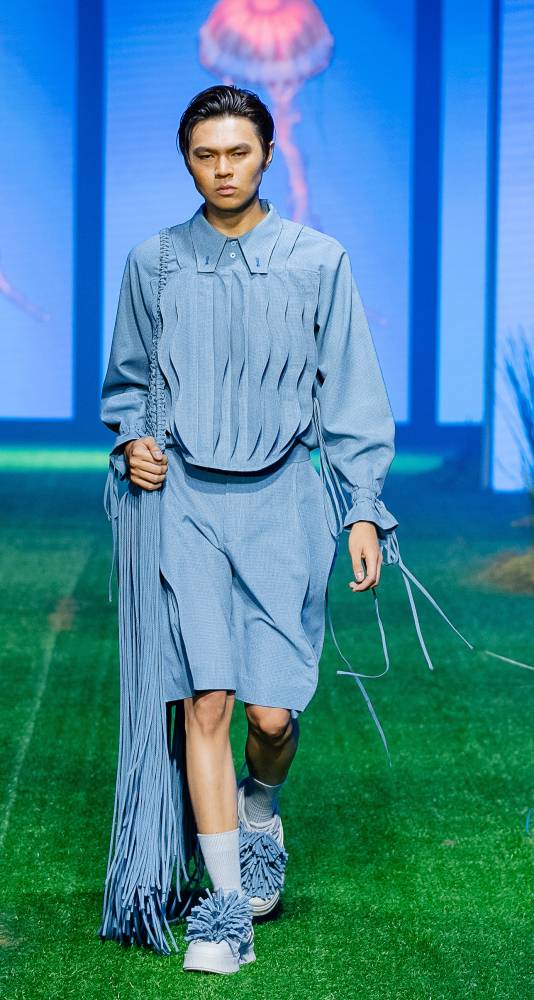
One male model sported a blue jellyfish t-shirt over a khaki pleated skirt and pants with multiple drawstrings for volume, maintaining a masculine aesthetic.
Gagula also referenced the nonchalance of beach dressing. “Sometimes you are in a hurry to get dressed, so you just drape your towel or clothes over your body and don’t wear them properly,” he said in Tagalog. These moments were interpreted as non-functional hanging sleeves and misshapen parts of a shirt sewn over the crotch area.
He hopes that his emerging brand, Peach Garde, can gain traction through the BDA.













